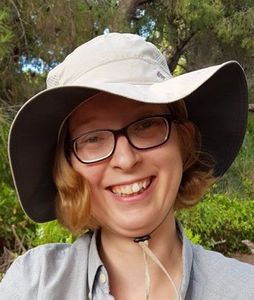Contact
Dr. Pauline N. Fleischmann
Research Group Fellow of the SFB 1372
Research focus
Cataglyphis ants are well-established experimental models to study the neuroethology of insect navigation. As typical solitary central place foragers, they use a variety of cues for navigation to return to their nest entrance – a tiny hole in the ground invisible from the ant’s perspective – after their far-ranging searches for food. The ants’ main navigational mechanism is path integration. For that, they combine celestial compass cues (e.g. the position of the sun and the UV polarization pattern) and information from their idiothetic step integrator to calculate a so-called home vector. Furthermore, Cataglyphis ants use visual, olfactory and tactile landmarks to home successfully. Before starting their foraging career outside the dark nest, the ants have to acquire all information necessary for successful navigation as foragers and to calibrate their compass systems. For that, they perform learning walks. During these short, explorative trips, the ants frequently look back to the nest entrance to take snapshots of their homing direction. Surprisingly, the ants use the earth’s magnetic field to align their gaze directions, and do not rely on celestial cues as they do during foraging. It is an open question why Cataglyphis ants use two different compass systems (celestial compass and magnetic compass) for path integration and how these two systems are linked. To understand the navigational capacities and the magnetic sense in Cataglyphis ants better, we aim to address the following questions:
- What are the characteristics of the magnetic compass in Cataglyphis ants? (behavioral biology)
- Where are the magnetic sensors located and how do they function? (sensory biology)
- How is compass information processed and integrated in the brain? (neurobiology)
To find answers to these key questions, we perform both behavioral and neurobiological experiments in the field in Greece and in the lab in Oldenburg.
Five selected publications (peer-reviewed)
Grob, R., Wegmann, J. W., Rössler, W., and Fleischmann, P. N. (2024). Cataglyphis ants have a polarity-sensitive magnetic compass. Curr. Biol., 34(24), 5833-5838, https://doi.org/10.1016/j.cub.2024.11.012.
Grob, R., Müller, V. L., Grübel, K., Rössler, W., and Fleischmann, P. N. (2024). Importance of magnetic information for neuronal plasticity in desert ants. Proceedings of the National Academy of Sciences, 121(8), e2320764121, https://doi.org/10.1073/pnas.232076412.
Fleischmann, P. N., Grob, R. and Rössler, W. (2022). Magnetosensation during re-learning walks in desert ants (Cataglyphis nodus). J. Comp. Physiol. A., 208, 125-133, https://doi.org/10.1007/s00359-021-01511-4.
Zeil, J., and Fleischmann, P. N. (2019). The learning walks of ants (Hymenoptera: Formicidae). Myrmecol. News, 29, 93-110, https://doi.org/10.25849/myrmecol.news_029:093.
Fleischmann, P. N.*, Grob, R.*, Müller, V. L., Wehner, R. and Rössler, W. (2018). The Geomagnetic Field Is a Compass Cue in Cataglyphis Ant Navigation. Curr. Biol., 28, 1440-1444, https://doi.org/10.1016/j.cub.2018.03.043.


